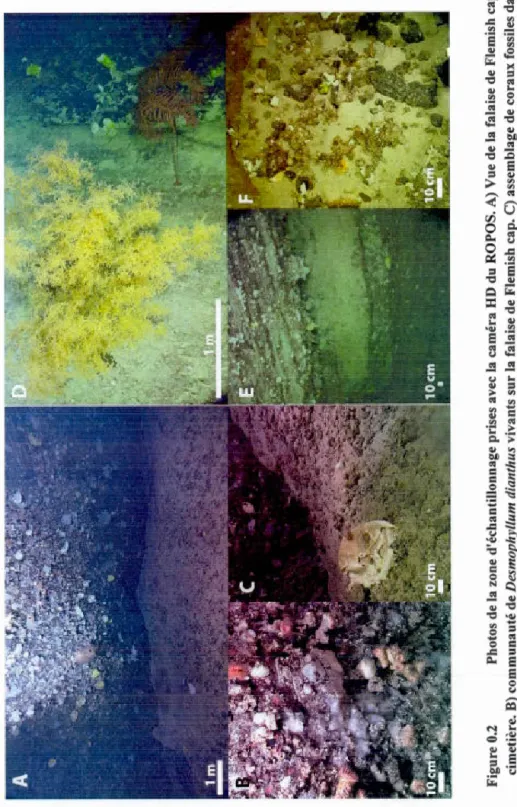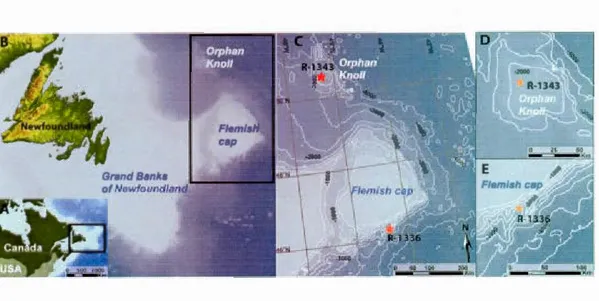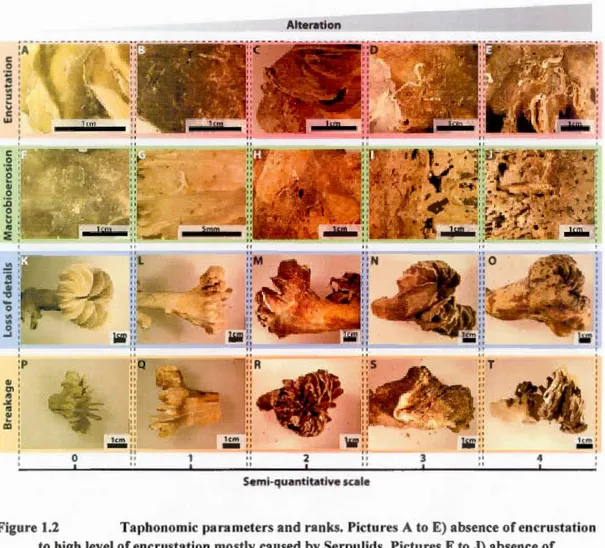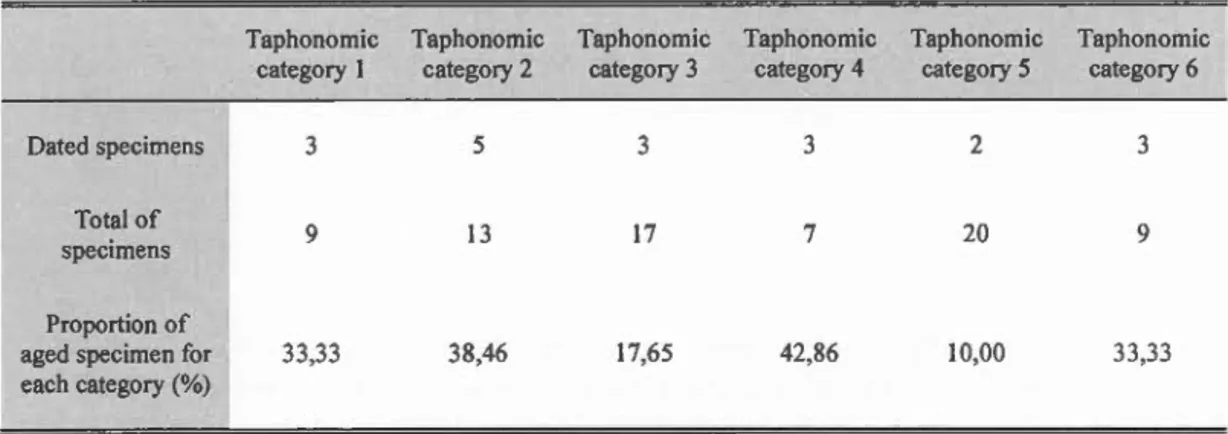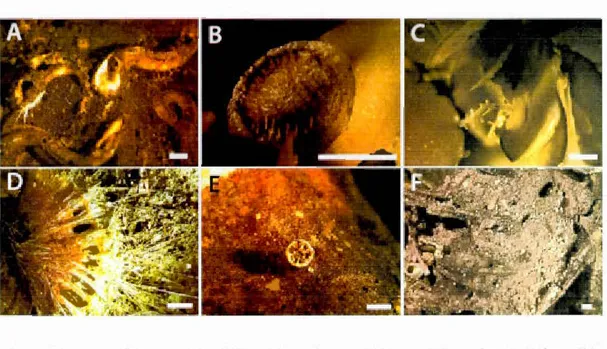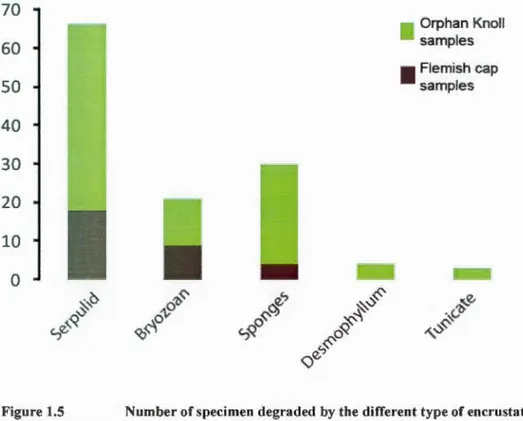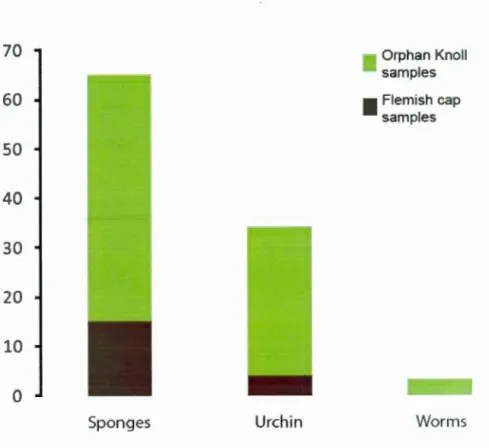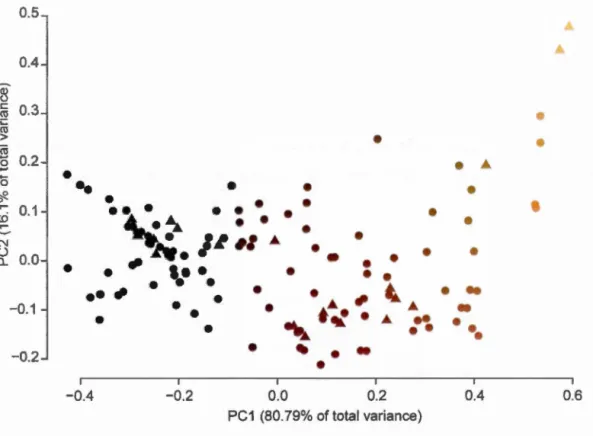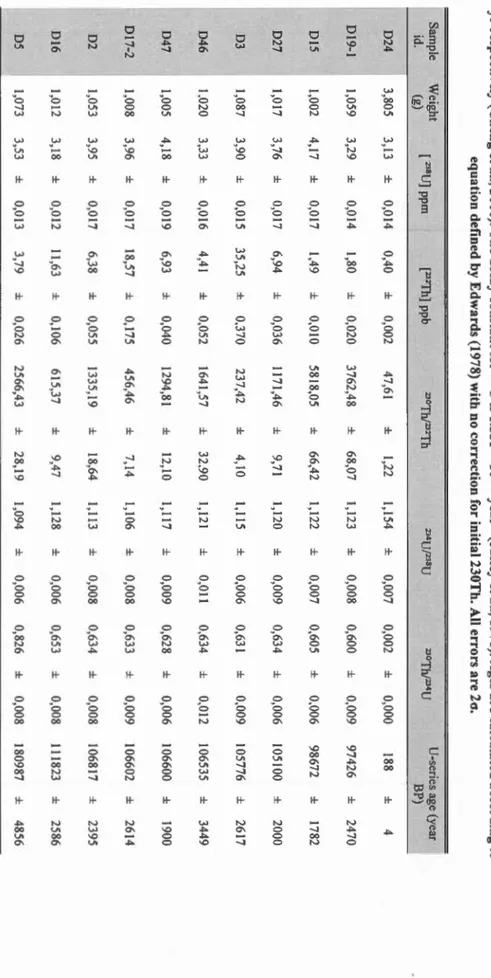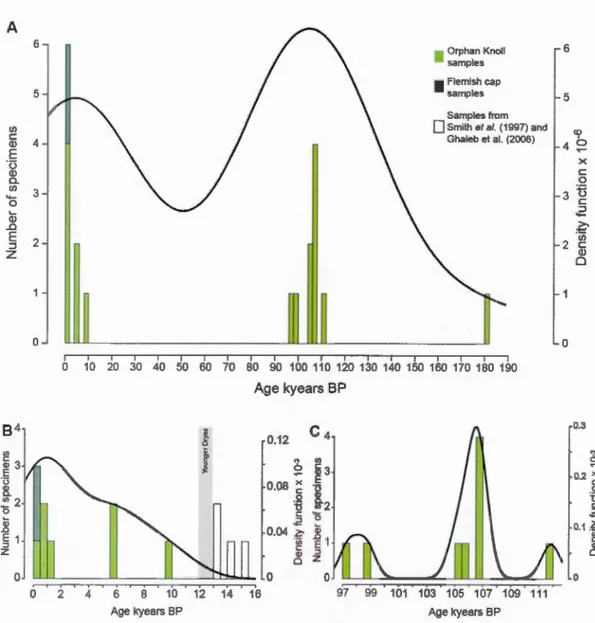LA TAPHONOMIE DES
CORAUX PROFONDS DES
CIMETIÈRES
SOUS-MARINS D'ORPHAN KNOLL ET DE FLEMISH CAP, UNE ÉTUDE
PRÉLIMINAIRE AUX ANALYSES GÉOCHIMIQUES
MÉMOIRE
PRÉSENTÉ
COMME EXIGENCE PARTIELLE
DE LA MAÎTRISE EN
SCIENCES DE LA TERRE
PAR
BLÉNET AURÉLIEN
Avertissement
La diffusion de ce mémoire se fait dans le respect des droits de son auteur, qui a signé le formulaire Autorisation de reproduire et de diffuser un travail de recherche de cycles supérieurs (SDU-522 - Rév.0?-2011 ). Cette autorisation stipule que «conformément
à
l'article 11 du Règlement no 8 des études de cycles supérieurs, [l'auteur] concèdeà
l'Université du Québecà
Montréal une licence non exclusive d'utilisation et de publication de la totalité ou d'une partie importante de [son] travail de recherche pour des fins pédagogiques et non commerciales. Plus précisément, [l'auteur] autorise l'Université du Québecà
Montréalà
reproduire, diffuser, prêter, distribuer ou vendre des copies de [son] travail de rechercheà
des fins non commerciales sur quelque support que ce soit, y compris l'Internet. Cette licence et cette autorisation n'entraînent pas une renonciation de [la] part [de l'auteur]à
[ses] droits moraux nià
[ses] droits de propriété intellectuelle. Sauf entente contraire, [l'auteur] conserve la liberté de diffuser et de commercialiser ou non ce travail dont [il] possède un exemplaire.»Je tiens tout d'abord à remercier mes deux superviseurs : M. Claude Hillaire-Marcel et M. Evan Edinger. Sans leur aide, leurs conseils, leur expérience et leur patience, jamais cette étude n'aurait abouti à la conclusion matérialisée par le présent mémoire. Plus particulièrement je remercie Claude Hillaire-Marcel pour m'avoir donné la chance d'être son étudiant ainsi que l'opportunité et les moyens d'effectuer cette recherche. Je remercie Evan Edinger pour m'avoir offert l'opportunité de venir travailler au Canada, pour la transmission de son savoir et pour son amitié.
Je remercie également toute ma famille qui a su me soutenir dans les choix que j'ai pu faire et qui a toujours été là dans les bons comme dans les mauvais moments.
À mes
parents à qui je dois mon intérêt pour les sciences naturelles, à mes soeurs pour leurs encouragements qui même distant de plusieurs milliers de kilomètres ont su me pousser de l'avant et à mes grands parents qui savent me rappeler que si le passé estimportant l'avenir l'est tout autant.
Je remercie tous mes collègues et amis du GÉOTOP et du département des sciences de la Terre de I'UQAM. Dans ce genre de liste il y a généralement beaucoup d'oubliés aussi je vais les remercier d'abord, car toutes les interactions, discussions et autres moments de détente ont contribué à l'achèvement de ce travail. Merci donc à tous les oubliés. Je tiens à remercier Antoine Thibault pour sa franche camaraderie, Mathieu Chevalier, Florianne Moreira, Marie-Michelle Ouellet-Bernier et Geneviève Vautour pour leur amitié et grâce à qui j'ai vraiment apprécié mon temps passer à travailler à I'UQAM. Aurélie Aubry et Nicolas Pujol pour m'avoir supporté dans le bureau.
Laurence Nuttin pour son empathie. J.B. Poulihnec pour nos discussions à batons rompus. Un grand merci également à Bassam Ghaleb pour sa gentillesse et son intelligence. Merci à André Poirier pour sa franchise et sa bonne camaraderie. Je remercie toutes les personnes qui de près ou de loin ont participé à ce projet : Pauline Méjean, Lucie Ménabréaz, Jenny Maccali, Nicolas Van Neuwenhove, Quentin Simon, Audrey Limoges.
Je tiens également à remercier Michel Lamothe, Daniele Pinti et Anne de Vernal qui m'ont permis d'enseigner pendant ma maîtrise.
Je remercie aussi Pierre-Olivier Bruna, Florianne Bruna et Antoine Faure pour leur bons conseils géologiques ou non. Je tiens également à remercier Marc Floquet et Loïc Villier, mes anciens maîtres, pour m'avoir introduit dans le monde de la recherche scientifique.
Je remercie enfin DFO et NSERC pour av01r financé la mission du ROPOS sur l'Hudson au large de Terre Neuve en 201 O.
"Here lies one whose name was wril in water."
John Keats (1795- 1821)
Je prie le lecteur de ne pas considérer seulement cette épitaphe comme de simples élans romantiques, mais bien comme l'expression du poète John Keats exprimant la brièveté des traces que laisse un être vivant à sa mort. Cette seule phrase exprime la raison d'être de la taphonomie. Car en effet si la vie d'un homme se résumait à un livre biographique, il en manquerait bien des pages. Celles que d'autres ou lui-même auraient oublié. Il en va de même pour l'histoire de la vie. Les lacunes stratigraphiques sont autant de pages manquantes que les organismes non préservés par la fossilisation sont de mots effacés.
Notre compréhension de l'évolution des paléo-environnements au cours du temps se heurte à ce problème majeur. Et malheureusement c'est un problème qui va croissant au fur et à mesure que l'on remonte dans le temps. Quantifier cette perte d'information est l'un des buts de la taphonomie expérimentale. C'est ainsi, par exemple, que le groupe du SSETI (pour Shelf and Slope Experimental Taphonomy Initiative) travaille sur la dégradation de coquilles de mollusques dans le golfe du Mexique depuis 1997. L'intérêt de ce type de recherche étant de comprendre, grâce au principe de l'actualisme, comment dans des environnements similaires, les restes organiques se sont dégradés par le passé.
Cette recherche s'inscrit dans la droite ligne de ces travaux de taphonomie expérimentale. En effet l'opportunité nous est ici donnée d'observer la dégradation de restes organiques, sur une longue période de temps, dans un environnement très particulier qu'est le milieu marin profond. Nous nous proposons ainsi de contribuer à la compréhension de ces phénomènes qui dégradent l'information au cours du temps. Nous tâchons de proposer les outils adaptés afin de permettre de recoller une partie des pages manquantes et retrouver une partie des mots effacés.
REMERCIEMENTS ... v
AVANT -PROPOS ... vii
LISTE DES FIGURES ... xiii LISTE DES TABLEAUX ... xvii
RÉSUMÉ ... xix
INTRODUCTION ... 1
0 . 1 Références ... 9
CHAPITREI DEEP-SEA CORALS FROM ORPHAN KNOLL: TAPHONOMIC PROCESSES IN A LOW BURIAL RA TE ENVIRONMENT SIN CE 180 000 YEAR ... I7 1.1 Abstract. ... 17 1.2 lntroduction ... l8 1.3 Methods ... 21 1.3.1 Location ... 21 1.3.2 ROPOS equipment.. ... 22 1.3.3 Sampling ... 23 1.3.4 Videos analysis ... 23
1.3 .5 Sample selection for taphonom ic studies ... 23
1.3.6 Analyses of corals preservation ... 24
1.3.7 Taphonomic ranks description ... 26
1.3.8 Statistical description oftaphonomic variables ... 28
1.3.1 0 Radiocarbon dating ... 29
1.3.11 U-series dating ... 30
1.3.12 Statistics for distribution curve ... 31
1.3.13 Re1ationship between taphonomic index and sample age ... 32
1.3.14 Relationship among taphonomic variables ... 32
1.4 Results ... 33
1.4.1 Samp1e area description ... 33
1.4.2 Taphonomic description ... 34
1.4.3 Radiocarbon and U-series dating ... .40
1.4.4 Taphonomic parameters vs sample age ... .45
1.4.5 Relation between taphonomic parameters ... 50
1.5 Discussion ... 54
1.5 .1 Effect of burial. ... 54
1.5.2 Taphonomy processes through time in deep-sea ... 56
1.5.3 Shallow marine and deep-sea environment comparison ... 58
1.5.4 Paleoceanographic implications of coral age distribution ... 60
1.6 Conclusion ... 64 1.7 References ... 65 CHAPITRE Il CONCLUSION ... 77 2.1 Références ... 80 APPENDICE A SÉLECTION DES ÉCHANTILLONS GRÂCE
A
DES CRITÈRES TAPHONOMIQUES ... 81A.1 Description des paramètres ... 81
A.2 Enregistrement des données ... 87
APPENDICE B
MÉTHODE DE NETTOYAGE ET DATATION U/Th ... 89
B. 1 Nettoyage ... 89
B.l.l Nettoyage physique ... 89
B.1.2 Nettoyage chimique ... 89
B.2 Datation U/Th ... 90
B.2.3 Préparation du traceur ... 90
B.2.4 Récupération chimique de l'Uranium et du Thorium ... 90
B.2.5 Séparation de l'Uranium et du Thorium ... 91
B.2.6 Mesure au spectromètre de masse ... 91
B.3 Références ... 92
LISTE DES FIGURES
Figure Page
Figure 0.1 profondeur des environnements des études taphonomique en relation avec la durée de dégradation des restes organiques ... 3 Figure 0.2 Photos de la zone d'échantillonnage prises avec la caméra HD du
ROPOS. A) Vue de la falaise de Flemish cap et du cimetière. B) communauté de Desmophyllum dianthus vivants sur la falaise de Flemish cap. C)
assemblage de coraux fossiles dans le cimetière de Flemish cap. D) Vue de la falaise d'Orphan Knoll, l'échelle est centrée sur le milieu de l'image. E) Vue de la falaise Orphan Knoll. F) Assemblage de coraux profond fossiles dans le cimetière sous la falaise d'Orphan Knoll ... 8 Figure 1.1 Location oftwo deep-sea graveyards (red stars) investigated during the
2010 Hudson mission off the coast ofNewfoundland. A) Map of North-Eastern American margin. B) Map ofNewfoundland and the location of Orphan Knoll and Flemish cap. C) Bathymetrie map ofürphan and Flemish cap and the location of the deep-sea corals graveyards, the interval between the levellines is 500 meter. D) Detail of the bathymetrie map focused on Orphan knoll and the position ofthe graveyard. E) Detail of the bathymetrie map focused on Flemish cap and the position of the graveyard ... 22 Figure 1.2 Taphonomic parameters and ranks. Pictures A to E) absence of
encrustation to high leve! of encrustation mostly caused by Serpulids. Pictures F to J) absence of macrobioerosion to high level mostly caused by action of lithophagous organisms and sea urchins. Pictures K to 0) full y clear details to complete loss of details on whole parts of the skeleton. Pictures P to T) weil preserved skeleton to heavily broken skeleton ... 25 Figure 1.3 Total of degraded specimen by rank of each taphonomic processes in
function ofthe location where they have been collected. A) Macrobioerosion rank distribution in function of the number of specimen. B) Loss of details rank distribution in function of the number of specimen. C) Encrustation rank distribution in function of the numbers of specimen. D) Breakage ranks distribution in fuction of the number of specimen ... 35
Figure 1.4 Pictures of the different type of encrustation (scale bar= 2mm). A) Serpulid calcite tube. B) Bryozan dise. C) Branching bryozoan. D) Sponge spicules. E) Juvenile D. dianthus. F) Tunicate ... 36 Figure 1.5 Number of specimen degraded by the different type of encrustation,
sponges and tunicate are soft bodied organisms. Total D. dianthus population n=l42, collected in Orphan Knoll and Flemish Cap ... 37 Figure 1.6 Pictures of different type of macrobioerosion (scale bar= 2mm). A)
Entobia made by endolithic sponges. B) Grazing traces made by sea urchins.
C) Gallery in D. dianthus skeleton made by endolithic worm ... 37 Figure 1.7 Number of specimen degraded by the different type ofmacrobioerosion.
Total D. dianthus population n=I42, collected in Orphan Knoll and Flemish Cap ... 38 Figure 1.8 Pictures of col our diversity of D. dianthus mostly caused by precipitation
of Mn oxide coating (scale bar= 1 cm). A) 039 sample. B) D 14 sample. C)
D5 sample. D) D59 sample ... 38 Figure 1.9 Scatter diagram ofPCA result on colour data from D. dianthus
population collected inü.K. The first axis is strongly related with dark/fair difference and explain 80.79% of the data dispersion. The second axis exp lain 16.1% of the total popaltion variance and is strongly related to red gradient. This diagram was realized using R software on a total D. dianthus population n=l42m. Triangles are for Flemish Cap specimens, dots for Orphan Knoll specimens ... 39 Figure 1.10 age distribution diagram and predicted distribution curves using
equation 1 on Orphan Knoll samples, h represent the smoothing parameter and n the number of sam pies the density function calculated with equation 1 is the probability density function ofthe sample distribution. A) Distribution for the fulllength oftime represented by our sample suite (n = 17, h = 2.98Ie4) age bins 2,000 years. B) Detail ofthe distribution for the Holocene and associated density curve (n = 7, h = 2227), age bins 500 years. C) Detail of the distribution for the MIS 5 with the associated density curve (n = 9, h = 672.6) age bins 500 years ... .43 Figure 1.11 Cluster analysis of the total specimen population using the taphonomic
rank leve!. Aged specimen are colored marked in function of the ir age. The four groups were determined by the software using the height. Triangles are for Flemish Cap specimens, dots for Orphan Knoll specimens ... .44
Figure 1.12 Taphonomic ranks distribution for aged samples (n=l8), with logarithmic regression curves, horizontal error bar were acquired during experimentation. Because of the horizontal scale sorne dot are overlapped, green are for Orphan Knoll samples and dark grey for Flemish cap sam pies. Ali the ages are cal. BP. A) Macrobierosion distribution B) Loss of details distribution. C) Encrustation distribution. D) Breakage distribution ... 46 Figure 1.13 Detailed taphonomic ranks distribution for aged samples (n=18),
horizontal error bar were acquired during experimentation. Because of the horizontal scale sorne dot are overlapped, green are for Orphan Knoll samples and dark grey for Flemish cap samples. Ali the ages are cal. BP. A) Sponges macroboring distribution B) Encrustation of serpulids tubes distribution. C) Encrustation of sponges distribution. D) Sea urchin grazing traces distribution ... 48 Figure 1.14 Dispersion diagramm using colour PCA data and dated specimen. The
first axis wich is strongly related to dark/fair difference explain 81.95% of the data dispersion. Green colour marked live collected specimen, orange and red the Holocene specimen, purple for the MIS 5 specimen and blue for MIS 7 specimen. Triangles are for Flemish Cap specimens, dots for Orphan Knoll specimens ... 49 Figure 1.15a taphonomic rank distribution the left column is for samples collected
at Orphan Knoll the right column for samples collected at Flemish cap. A) Loss of details rank distribution in function of macrobioerosion index. B) Encrustation rank distribution in function of macrobioerosion index. C) Breakage rank distribution in function of macrobioerosion index. D) Same as A for Flemish cap. E) Same as B for Flemish cap. F) Same as C for Flemish cap. . ... 51 Figure 1.15b taphonomic rank distribution the left column is for samples collected
at Orphan Knoll the right column for sam pies collected at Flemish cap. A) Breakage rank distribution in function of loss of details index. B)
Encrustation rank distribution in function of loss of details index. C) Encrustation rank distribution in function ofbreakage index. D) Same as A for Flemish cap. E) Same as B for Flemish cap. F) Same as C for Flemish cap. . ... 52 Figure 1.16 Dispersion diagramm using colour PCA data and the other taphonomic
processes ranks. A) Macrobioerosion ranks dispersion. B) Loss of details ranks dispersion. C) Encrustation ranks dispersion. D) Breakage ranks
dispersion. Triangles are for Flemish Cap specimens, dots for Orphan Knoll specimens ... 53 Figure 1.17 mode! for taphonomic processes recording through realtive time. The
saturation value represent the highest value on the semi-quantitative scale .. 57
Figure 1.18 position of the polar front during Last Glacial period modified from
Thiagarajan et al. (20 13) and the actual position of the polar front in the Labrador Sea, data from Montserrat et al. (20 1 1 ). Zone where 0. d ianthus were collected are pointed with red plots. New England and Corner Rise seamounts were investigated by Thiagarajan et al. (20 13), Orphan Knoll and Flemish cap deep-sea corals graveyards were investigated during Hudson cru ise in 201 O ... 62 Figure A.1 Clichés de D. dianthus, scale barr= 0.5 mm. A) Septa de l'échantillon
057 comprenant : C=cassure de niveau 1 et R= rugosité. B) Epithéca de
l'échantillon 047 comprenant: O=ornementation. C) Vue d'ensemble de
l'échantillon 057 montrant les différentes parties du corail : S=Septa,
Tableau Page Tableau 1.1 Number of taphonomicaly studied specimens from each location and
the number al ive or subfossils analyzed for age distribution by 14C or V-series from each locations (total = 19) ... 24 Tableau 1.2 Number of specimen from each taphonomic category. Those category
are the result of the evaluation of diferrent parameters as colour (Mn oxide), macro-boring, encrustation , breakage and loss of details ... 29 Tableau 1.3 813C, 818
0
and ages obtained on deep-sea corals samples*=live-collected specimen, ** = Flemish cap specimen. 813C and radiocarbon datation for lsidids D22 and D23 were run at ANU lab, with 818
0
analyzed separately at GEOTOP laboratory therefore not really a split sample. For the other radiocarbon datating samples, datation were run in CEA Saclay center and stables isotopes in GEOTOP laboratory on the same sub-sample. For the U-series datating samples analyses, including stable isotopes, were made in GEOTOP laboratory on the same sub-sample ... .41 Tableau 1.4 U-series ages measured by TIMS. Half-lives of234U and 230Th used inthe calculations are 245,250 ± 490 yrand 75,690 ± 230 yr respective( y (Cheng et al., 2000). The decay constant for 238U is 1.551 x 10-10 year-1 (Jaffey et al., 1971). Ages are calculated according to equation defined by Edwards (1978) with no correction for initial 230Th. Ali errors are 2cr ... 42 Tableau 1.5 Kruskall Wallis rank sum test differenciating each population
(Holocene vs Pleistocene) for each parameter. ... .47 Tableau 1.6 Kendall correlation rank test results between the different parameters. T
represent the strength of association for each parameter in row with the one in column. A value of 1 is for a perfect association and 0 the absence of association ... 50 Tableau 1. 7 Kendall coefficient test between col our and taphonomic parameters. W
is Kendall's coefficient of concordance, F = W*(m-1)/(1-W) where mis the number ofjudges, Prob.F is the prabability associated with F statistic, the
Chi2 is Friedman's Ch? statistic and Prob.perm is the permutation
probability ... 54 Tableau B.l procédures de nettoyage chimique ... 90
Le but principal de cette recherche est d'étudier la dégradation de coraux azooxanthelles dans un environnement marin profond et de comprendre l'occurrence des fossiles de Desmophyllum dianthus basée sur leur datation dans les cimetières sous-marin d'Orphan Knoll et de Flemish cap. 19 squelettes de coraux ont été datés en utilisant la méthode du radiocarbone et 11 de ces spécimens ont été daté par la
méthode U/Th. Trois différentes populations de coraux ont été identifiées : une
population Holocène (73 à 10000 ans BP) , une population du Stade Marin Isotopique
5 (97000 à 112000 ans BP) et un spécimen datant du Stade Marin Isotopique 7 (181000 années BP). Cette distribution a été reliée au déplacement Nord/Sud sud du front polaire entre les périodes interglaciaire et glaciaires. 142 spécimens de coraux
de la mer du Labrador ont été analysés taphonomiquement et les différents processus
taphonomiques ont été identifiés. Ces processus ont été quantifiés en utilisant une échelle semi-quantitative. Il a été démontré que dans cet environnement de basse vitesse de sédimentation, l'échantillon reste sur le fond de la mer sur une longue période de temps. Le taux d'enfouissement lent explique les principales différences observées entre milieu marin profond et peu profond. L'utilisation de tests statistiques
a montré que la plupart des processus taphonomiques liés à l'âge des spécimens sont
causés par la micro et la macro bioerosion issue de l'action d'éponges, d'oursins et de
micro-organismes. Une valeur de saturation du signal taphonomique a été définie
pour chaque processus. Cette valeur est atteinte à différents moments selon le
processus taphonomique étudié. Ces différences, illustrées par des analyses
multivariées, sont les clefs pour comprendre les relations entre les processus de dégradation et leur enregistrement sur le squelette d'un organisme en milieu marin profond.
Mots clefs : paléontologie, taphonomie, milieu profond, radiocarbone, U/Th, mer du Labrador
-
-L'étude et la compréhension du monde qui nous entoure passe par l'étude de son
passé et par la compréhension des changements qui sont intervenus depuis lors. Les témoignages de ces changements laissent des traces analysables dans les
enregistrements fossiles que sont les roches sédimentaires et les assemblages fossiles
qu'elles contiennent. Cependant plus loin on remonte dans le passé, plus ces archives sont incomplètes (AIIison et Bottjer, 2011). En effet au cours des temps géologiques
de nombreux facteurs, faisant partie de la télogenèse, de la diagenèse tardive ou du métamorphisme, dégradent les enregistrements fossiles (Andrews, P., 1995 ; Powell, W., 2003). Ces processus se produisent longtemps après l'enfouissement et la fossilisation des restes organiques. D'autre facteurs interviennent eux directement
après la mort des organismes et perdurent jusqu'à leurs fossilisation. Ces facteurs concernent les passages de biocénose à thanatocénose et de thanatocénose à taphocénose (Fürsich et Pandey, 1999). Leur étude, qui vise à comprendre la dégradation des restes organiques au cour du temps, est appelée taphonomie
(Efremov, 1940).
En milieu marin les processus taphonomiques qui affectent les assemblages de restes
organiques commencent au cours du vivant de l'organisme, comme l'encroutement, la bioerosion ou la lithification (Friedman, 1964 ; Ginsburg, 1954 ; Nothdurft et Webb,
2009 ; Strasser et Strohmenger, 1997). Ces processus ont un impact sur la préservation des coquilles dans les enregistrements fossiles et influent sur les
reconstitutions des conditions environnementales passées (Efremov, 1940). En
préservant les organismes préférentiellement squelettiques en fonction de la minéralogie de leur squelette ou leur résistance, les processus taphonomiques
introduisent un biais dans les archives fossiles pour la reconstruction de la biodiversité passé (Cherns et Wright, 2009). Certains de ces processus sont causés par des organismes qui ont utilisé les squelettes comme habitat ou sources d'alimentation. Ces organismes comme les algues et les cyanobactéries qui corrodent squelette sont restreints à la zone photique et ne peuvent pas vivre sur la pente ou en environnement marin profond. De plus certaines espèces bioérodeuses comme certains oursins dépendent de ces organismes pour s'alimenter. Le panel d'organismes corrodeurs va donc lui aussi dépendre de l'environnement et être plus restreint en environnment profond. Les processus taphonomiques sont dépendant de l'environnement de dépôt des assemblages des restes organiques.
Les processus de dégradation des environnements marins peu profonds sont de plus en plus documentés ces dernières décennies, notamment par Shelf and Slope Experimental Taphonomy Initiative group (SSETI). Leurs études ont permis de quantifier les processus de dégradation dans divers milieux marins (Parsons, Powell, Brett, Walker et Cal tender, 1997). Des études à court terme -± 1 0 ans -(Fig.O.I) ont été réalisées sur plateau continental et la rampe carbonatée des Bahamas (Cai, Chen, Powell, Walker, Parsons-Hubbard, Staff, Wang, Ashton-Aicox, Callender et Brett, 2006 ; Powell, Eric N, Parsons-Hubbard, Callender, Staff, Rowe, Brett, Walker, Raymond, Carlson et White, 2002 ; Powell, Eric N., Parsons-Hubbard, Callender, Staff, Rowe, Brett, Walker, Raymond, Carlson, White et Heise, 2002 ; Walker, Parsons Hubbard, Powell et Brett, 1998). Selon ces études l'influence des cycles d'inhumation et d'exhumation est le phénomène permettant d'expliquer les processus taphonomiques observés (Parsons-Hubbard, Callender, Powell, Brett, Walker, Raymond et Staff, 1999 ; Staff, Callender, Powell, Parsons-Hubbard, Brett, Walker, Carlson, White, Raymond et Heise, 2002). Le taux de dégradation sur le plateau continental est plus rapide que sur la rampe et est lié au taux d'enfouissement des restes organiques. Dans un environnement plus profond et en particulier en bas de pente, le taux de dégradation doit être plus lent en raison des conditions
hydrodynamiques faibles, de l'absence d'organismes encroutants photosynthétiques
comme les algues et les cyanobactéries et la baisse de l'activité des organismes
corrodeurs (Walker, Parsons-Hubbard, Powell et Brett, 2002). L'échelle de temps et le taux d'enfouissement sont donc les paramètres les plus importants afin de comprendre les processus taphonomiques.
20 VI Q) lo.... ... -Q) E ::::l 200 Q) ""0 c 0 4 -0 lo.... 2000 a.. Figure 0.1
Echelle de temps de l'expérimentation
Mois Années Décennies Siècles
Majorité des études Freiwald etal. 2002 Etudes du
+
SSETI Boerboom1
et al. 1998 Cette étudeprofondeur des environnements des études taphonomique en relation avec la
durée de dégradation des restes organiques.
Le rapport entre le taux de sédimentation et le taux d'accumulation de coquilles va déterminer le temps moyen pendant lequel les restes organique vont demeurer à l'interface eau sédiment et la rapidité avec laquelle ils seront enfouis. Plus le temps de résidence au fond de la mer des coquilles augmentent plus leur dégradation augmente (Fiessa, Cutler et Meldahl, 1993). De plus des variations de ce temps de résidence provoquent des pertes d'informations stratigraphiques en associant des assemblages
fossiles qui n'étaient contemporains (Kowalewski, Michal, 1996 ; Kowalewski,
Michat et Bambach, 2008 ; Kowalewski, M, Carroll, Casazza, Gupta, Hannisdal,
Hoffmeister, 2003), faussant les interprétations paléo-écologiques issues de l'analyse des assemblages fossiles. Ce temps de résidence peut-être déduit grâce à l'étude de la distribution des âges des coquilles composant les assemblages fossiles (Bambach, 1977 ; Fursich et Aberhan, 1990). Les dépôts de fossiles perturbés par ces variations sont dits time averaged. Dans un environnement marin profond, notamment dans le cas d'un cimetière à corail, malgré le faible taux d'accumulation de squelettes, le faible taux de sédimentation, peut provoquer la formation d'une zone à fort taux de résidence. C'est dépôt peuvent donc être time averaged.
Cette étude porte donc sur la compréhension des processus taphonomiques en milieu marin profond et sur leur influence quant à la préservation de l'information paléo-environnementale que peuvent fournir les squelettes de Desmophyllum dianthus. L'étude des coraux profonds a gagné beaucoup d'importance ces dernières décennies.
Depuis leur découverte au 18ème siècle par Linné (1758), leur importance pour la pérennité des écosystèmes marins profonds à été mis en évidence (Auster, 2005 ; Auster, Moore, Heinonen et Watling, 2005 ; Costello, McCrea, Freiwald, Lundalv, Jonsson, Bett, van Weering, de Haas, Roberts et Allen, 2005 ; Mortensen, Pal Buhl, Rapp et Bamstedt, 1998).
À
l'heure d'importants changements environnementaux,leur protection est devenue une priorité pour la communauté scientifique (Costello et al., 2005 ; Edinger, Evan N, Wareham et Haedrich, 2007 ; Mortensen, P. B., Buhl-Mortensem, Gordon Jr., Fader, McKeown et Fenton, 2005). Leur étude a permis de comprendre le fonctionnement de ces écosystèmes profonds (Auster et al., 2005) mais donne aussi de précieux renseignements sur l'évolution du climat et les changements environnementaux au cours de ces derniers milliers d'années notamment par le biais de l'analyse géochimique de leur squelette (Roberts, J. M., Wheeler, Freiwald et Cairns, 2009).
Afin d'étudier ces changements environnementaux, une attention particulière a été accordée à la composition isotopique de leurs squelettes. En effet en raison de leur
longévité (Andrews, A., Stone, Lundstrom et DeVogelaere, 2009 ; Roark, E. B., Guilderson, Dunbar et Ingram, 2006 ; Roark, E Brendan, Guilderson, Flood-Page, Dunbar, Ingram, Fallon et McCulloch, 2005 ; Sherwood, O. A. et Edinger, 2009 ; Tracey, Neil, Marriott, Andrews, Cailliet et Sanchez, 2007) ces organismes représentent un enregistrement continu sur plusieurs décennies des conditions environnementales prévalant lors de leur croissance. L'analyse des rapports en isotopes stables du carbone et de l'oxygène (Adkins, Boyle, Curry et Lutringer, 2003 ; Sherwood, Owen A, Heikoop, Scott, Risk, Guilderson et McKinney, 2005) ainsi que l'étude des rapports Sr/Ca (Cohen, Owens, Layne et Shimizu, 2002 ; Hill, LaVigne, Spero, Guilderson, Gaylord et Clague, 2012) et Mg/Ca (Gagnon, Adkins, Fernandez et Robinson, 2007) ont fourni des renseignements notamment pour estimer les paléotempératures. Les changements de conditions hydrographiques ont elles aussi pu être étudiées notamment grâce à l'utilisation des isotopes du Nd (Colin, Frank, Copard et Douville, 2010 ; L6pez Correa, Montagna, Joseph, Rüggeberg, Fietzke, FIOgel, Dorschel, Goldstein, Wheeler et Freiwald, 2012 ; Montagna, McCulloch, Mazzoli, S ilenzi et Odorico, 2007 ; van de FI ierdt, Robinson et Adkins, 201 0). Les méthodes de datation U/Th (Eisele, Frank, Wienberg, Hebbeln, L6pez Correa, Douville et Freiwald, 2011 ; Frank, Freiwald, Correa, Wienberg, Eisele, Hebbeln, Van Rooij, Henriet, Colin et van Weering, 2011) et C14 (Thiagarajan, Gerlach, Roberts, Burke, McNichol, Jenkins, Subhas, Thresher et Adkins, 2013) ont permis de relier leurs occurrences aux changements de productivité primaire liées aux changements climatiques globaux et aux déplacements du front polaire. La réponse de ces organismes aux changements environnementaux actuels et notamment à l'acidification des océans à elle aussi été étudiée (Form et Riebesell, 2012 ; Foster, Ragazzola, Wall, Form et Freiwald, 2012 ; Guinotte, Orr, Cairns, Freiwald, Morgan et George, 2006 ; Roberts, J Murray, Wheeler et Freiwald, 2006). Toutes ces études ont permis de mettre en évidence l'intérêt de l'étude géochimique des squelettes des
coraux profonds pour la compréhension des changements environnementaux passés et futurs.
Les récentes problématiques liées aux changements climatique ont amené la
communauté scientifique a adopter une approche globale des interactions entre atmosphère, système terre et océan. L'analyse de ces interactions est cruciale pour comprendre notamment les cycles cliamtiques notamment dans l'hémisphère Nord. Cela passe par la compréhension du cycle du carbone, de l'évolution de la
productivité primaire et des conditions hydrographiques des océans. Ainsi les projets
VITALS et Past4Future étudient l'évolution de ces systèmes afin de comprendre
l'évolution des conditions climatiques et paléocénographiques dans l'Atlantique Nord.
Des études notamment sur des carottes sédimentaires (Hillaire-Marcel, C, Vernal,
Bilodeau et Wu, 1994 ; Hillaire-Marcel, Claude, Vernal, Lucotte, Mucci, Bilodeau,
Rochon, Vallières et Wu, 1994 ; Simon, Hi !laire-Marcel, St-Onge et Andrews, 2013 ;
Solignac, de Vernal et Hillaire-Marcel, 2004) et des assemblages de foraminifères (de Vernal, Hillaire-Marcel, Peltier et Weaver, 2002) dans la Baie de Baffin et en mer du Labrador ont permis de reconstituer les conditions paléocéanographiques au cours de
l'Holocène et de confirmer leur intérêt pour la compréhension globale du système
climatique terrestre. La mission de l'Hudson en 2010 au large de TerreNeuve financée
par (DFO, NSERC), s'inscrit dans la compréhension de ces problématiques (Edinger,
Evan N. et al., 201 0).
Un des buts de cette mission était d'explorer les mounds découverts lors de
précédentes missions (Keen, 1978 ; Ruffman, 1989 ; Smith, Risk, Schwarcz et
McConnaughey, 1997) à Orphan Knoll et Flemish cap, situé au large de Terre-Neuve.
Deux cimetières à coraux profonds ont ainsi été localisé (O.K. : 50°N - 33.12', 46°W - 11.59' et F.c. : 46°N - 20.02', 44°W - 33') respectivement à 1740 mètres et 2200
mètres de profondeur. Des spécimens de coraux profonds appartenant principalement
(ROPOS pour Remotely Operated Platform for Ocean Science). Ces cimetières sous-marins se sont formés par l'accumulation de squelettes de D. dianthus provenant des falaises (Fig.0.2) surplombants ces formations (Meredyk, Piper, Edinger et Ruffman, 20 12b). Considérant le faible taux de sédimentation dans cette zone (Andrews, J., Tedesco, Briggs et Evans, 1994 ; Hillaire-Marcel, C et al., 1994), les squelettes coralliens ne sont pas enfouis rapidement mais restent exposés à l'interface eau/sédiment sur de longue période de temps.
Ces cimetières à coraux profonds trouvés au large de Terre-Neuve, sont donc le résultat d'une accumulation sur le long terme de squelettes aragonitiques de Desmophyllum dianthus. Dans un tel contexte la dégradation de ces restes organiques au cours du temps est à considérer afin de mieux aborder l'étude géochimique de ces squelettes à des fin de reconstitutions paléo-environnementales. Les objectifs de cette étude sont : 1) de comprendre en combien de temps et dans quelles conditions ont pu se former ces cimetières, 2) d'analyser la taphonomie dans ce milieu particulier à faible taux d'enfouissement et 3) de proposer une méthode pour aborder l'étude géochimique de ces restes organiques en tenant compte de leur dégradation.
Figure 0.2 Photos de la zone d'échantillonnage prises avec la caméra HD du ROPOS. A) Vue de la falaise de Flemish cap et cimetière. B) communauté de Desmopltyllum diant/tus vivants sur la falaise de Flemish cap. C) assemblage de coraux fossiles dans cimetière de Flemish cap. D) Vue de la falaise d'Orphan Knoll , l'échelle est centrée sur le milieu de l'image. E) Vue de la falaise Orphan Knoll. F) Assemblage de coraux profond fossiles dans le cimetière sous la falaise d'Orphan Knoll
9
0.1 Ftéférences
Adkins, J., Boyle, E., Curry, W. et Lutringer, A. (2003). Stable isotopes in deep-sea corals and a new mechanism for "vital effects". Geochimica et Cosmochimica Acta, 67(6), 1129-1143.
Allison, P.A. et Bottjer, D.J. (2011). Taphonomy: bias and process through time
Taphonomy (p. 1-17) : Springer.
Andrews, A., Stone, R., Lundstrom, C. et DeVogelaere, A. (2009). Growth rate and age determination ofbamboo corals from the northeastern Pacifie Ocean using refined 21 OPb dating. Marine Ecology Progress Series, 397, 173-185. http://dx.doi.org/1 0.3354/meps08193
Andrews, J., Tedesco, K., Briggs, W. et Evans, L. (1994). Sediments, sedimentation rates, and environments, south east Baffin Shelf and north west Labrador Sea, 8-26 ka. Canadian Journal of Earth Sciences, 31(1), 90-103.
Andrews, P. (1995). Experiments in taphonomy. Journal of Archaeological Science,
22(2), 147-153.
Auster, P.J. (2005). Are deep-water corals important habitats for fishes? Cold-water corals and ecosystems (p. 747-760): Springer.
Auster, P.J., Moore, J., Heinonen, K.B. et Watling, L. (2005). A habitat classification scheme for seamount landscapes: assessing the functional role of deep-water corals as fish habitat Cold-water corals and ecosystems (p. 761-769): Springer.
Bambach, R.K. (1977). Species richness in marine benthic habitats through the Phanerozoic. Paleobiology, 152-167.
Cai, W.-J., Chen, F., Powell, E.N., Walker, S.E., Parsons-Hubbard, K.M., Staff,
G.M., Wang, Y., Ashton-Aicox, K.A., Callender, W.R. et Brett, C.E. (2006). Preferential dissolution of carbonate shells driven by petroleum seep activity in the Gulf of Mexico. Earth and Planetary Science Letters, 248(1), 227-243.
Cherns, L. et Wright, V.P. (2009). Quantifying the impact ofearly diagenetic
aragonite dissolution on the fossil record. Palaios, 24, 756-771.
Cohen, A.L., Owens, K.E., Layne, G.D. et Shimizu, N. (2002). The Effect of Algal
Symbionts on the Accuracy of Sr/Ca Paleotemperatures from Coral. Science,
296(5566), 331-333. http://dx.doi.org/1 0.1126/science.l 069330
Colin, C., Frank, N., Copard, K. et Douville, E. (2010). Neodymium isotopie
composition of deep-sea corals from the NE Atlantic: implications forpast
hydrological changes during the Holocene. Quaternary Science Reviews, 10.1016, 1-9.
Costello, M.J., McCrea, M., Freiwald, A., Lundalv, T., Jonsson, L., Bett, B.J., van
Weering, T.C., de Haas, H., Roberts, J.M. et Allen, O. (2005). Rote of
cold-water Lophelia pertusa coral reefs as fish habitat in the NE Atlantic C
old-water corals and ecosystems (p. 771-805) : Springer.
de Vernal, A., Hillaire-Marcel, C., Peltier, W.R. et Weaver, A.J. (2002). Structure of the upper water column in the northwest North Atlantic: Modern versus Last
Glacial Maximum conditions. PALEOCEANOGRAPHY, 17(4), 1050.
Edinger, E.N. et al., e. (2010). NSERC ship-time cruise report; ROPOS mission
onboard the CCGS Hudson.
Edinger, E.N., Wareham, V.E. et Haedrich, R.L. (2007). Patterns of groundfish
diversity and abundance in relation to deep-sea coral distributions in Newfoundland and Labrador waters. Bulletin of Marine Science,
81(Supplement 1), 101-122.
Efremov, 1. (1940). Taphonomy: new branch of paleontology. Pan-American
Geologist, 74,81-93.
Eisele, M., Frank, N., Wienberg, C., Hebbeln, D., L6pez Correa, M., Douville, E. et
Frei wald, A. (20 Il). Productivity controlled cold-water coral growth periods
du ring the last glacial offMauritania. [doi: 10.1 016/j.margeo.201 0.12.007]. Marine Geology, 280(1-4), 143-149.
Flessa, K. W., Cutler, A.H. et Meldahl, K.H. (1993). Time and taphonomy:
quantitative estimates of time-averaging and stratigraphie disorder in a
shallow marine habitat. Paleobiology, 266-286.
Form, A.U. et Riebesell, U. (20 12). Acclimation to ocean acidification during
long-term C02 exposure in the cold-water coral Lophelia pertusa. Global Change Bio/ogy, 18(3), 843-853.
Foster, L.C., Ragazzola, F., Wall, M., Form, A.U. et Freiwald, A. (2012). The
biomineralisation response of the cold-water coral Lophelia pertusato ocean acidification.
Frank, N., Freiwald, A., Correa, M.L., Wienberg, C., Eisele, M., Hebbeln, D., Van Rooij, D., Henriet, J.-P., Colin, C. et van Weering, T. (2011). Northeastern Atlantic cold-water coral reefs and climate. Geology, 39(8), 743-746.
Friedman, G.M. (1964). Early diagenesis and lithification in carbonate sediments.
Journal ofSedimentary Research, 34(4), 777-813.
Fürsich, F. et Pandey, D. (1999). Genesis and environmental significance of Upper
Cretaceous shell concentrations from the Cauvery Basin, southern India.
Palaeogeography, Palaeoclimatology, Palaeoecology, 145(1), 119-139.
Fursich, F.T. et Aberhan, M. (1990). Significance oftime-averaging for palaeocommunity analysis. Lethaia, 23(2), 143-152.
Gagnon, A.C., Adkins, J.F., Fernandez, D.P. et Robinson, L.F. (2007). Sr/Ca and Mg/Ca vital effects correlated with skeletal architecture in a scleractinian deep-sea coral and the role of Rayleigh fractionation. Earth and Planetary Science Letters, 261(1), 280-295.
Ginsburg, R.N. ( 1954). Early diagenesis and lithification of shallow-water carbonate sediments in south Florida. : SEPM.
Guinotte, J.M., Orr, J., Cairns, S., Freiwald, A., Morgan, L. et George, R. (2006).
deep-sea scleractinian corals? Frontiers in Ecology and the Environment,
4(3), 141-146.
Hill, T., LaVigne, M., Spero, H., Guilderson, T., Gaylord, B. et Clague, D. (2012).
Variations in seawater Sr/Ca recorded in deep-sea bamboo corals.
PALEOCEANOGRAPHY, 27(3)
Hillaire-Marcel, C., Vernal, A.d., Bilodeau, G. et Wu, G. (1994). Isotope stratigraphy,
sedimentation rates, deep circulation, and carbonate events in the Labrador
Sea during the last~ 200 ka. Canadian Journal of Earth Sciences, 31(1 ), 63-89.
Hillaire-Marcel, C., Vernal, A.d., Lucotte, M., Mucci, A., Bilodeau, G., Rochon, A.,
Vallières, S. et Wu, G. (1994). Productivité et flux de carbone dans la mer du
Labrador au cours des derniers 40 000 ans. Canadian Journal of Earth
Sciences, 31(1), 139-158. http://dx.doi.org/doi:I0.1139/e94-012
Keen, C. (1978). Cruise Report CSS Hudson 78 020, June 27 to July 19, 1978. At/.
Geosc. Centre, Bedford lnst. Oceanogr., lnt. Rep, 1, 15.
Kowalewski, M. ( 1996). Time-averaging, overcompleteness, and the geological
record. Journal ofGeology, 104(3), 317-326. Récupéré de geh
Kowalewski, M. et Bambach, R.K. (2008). The limits of paleontological resolution.
: Springer.
Kowalewski, M., Carroll, M., Casazza,
L.
,
Gupta, N., Hannisdal, B., Hendy, A., Krause Jr, R., LaBarbera, M., Lazo, D. et Messina, C. (2003). Quantitativefidelity of brachiopod-mollusk assemblages from modern subtidal
environments of San Juan Islands, USA. Journal ofTaphonomy, 1(1), 43-65.
Kowalewski, M. et Hoffmeister, A.P. (2003). Sieves and fossils: Effects of mesh size
on paleontological patterns. PALAJOS, 18(4-5), 460-469.
L6pez Correa, M., Montagna, P., Joseph, N., Rüggeberg, A., Fietzke, J., Flogel, S.,
Dorschel, B., Goldstein, S.L., Wheeler, A. et Frei wald, A. (20 12). Preboreal
radiocarbon and U-series dating and neodymium isotopes. (doi:
10.10 16/j.quascirev.2011.12.005]. Quaternary Science Reviews, 34(0), 24-43.
Meredyk, S., Piper, D., Edinger, E. et Ruffman, A. (2012b). Composition, probable
origin, and recent coral fauna of enigmatic mounds on Orphan Knoll,
Northwest Atlantic Ocean. GAC-MAC annual meeting, Actes du colloque, 20 12b, St. John's, NL
Montagna, P., McCulloch, M., Mazzoli, C., Silenzi, S. et Odorico, R. (2007). The non-tropical coral Cladocora caespitosa as the new climate archive for the
Mediterranean: high-resolution (~weekly) trace element systematics. [doi:
10.101 6/j.quascirev.2006.09.008]. Quaternary Science Reviews, 26(3-4),
441-462.
Mortensen, P.B., Buhi-Mortensem, L., Gordon Jr., D.C., Fader, G.B.J., McKeown, D.L. et Fenton, D.G. (2005). Effects offisheries on deep water gorgonian corals in the Northeast Channel. NovaScotia.Am.Fish.Soc.Symp, 41, 369-382. Mortensen, P.B., Rapp, H.T. et Bâmstedt, U. ( 1998). Oxygen and carbon isotope
ratios related to growth line patterns in skeletons ofLophelia pertusa (L)
(Anthozoa, Scleractinia): Implications for determination of linear extension rate. (doi: 1 0.1080/00364827.1998.10413702]. Sarsia, 83(5), 433-446.
http://dx.doi.org/l
O.
1080/00364827.1998.10413702Nothdurft, L. et Webb, G. (2009). Earliest diagenesis in scleractinian coral skeletons:
implications for palaeoclimate-sensitive geochemical archives. Facies, 55(2),
161-201. http://dx.doi.org/ 10.1007 /s 1034 7-008-0 167-z
Parsons-Hubbard, K.M., Callender, W.R., Powell, E.N., Brett, C.E., Walker, S.E., Raymond, A.L. et Staff, G.M. (1999). Rates ofburial and disturbance of experimentally-deployed molluscs; implications for preservation potential. PALAIOS, 14(4), 337-351.
Parsons, K.M., Powell, E.N., Brett, C.E., Walker, S.E. et Callender, W.R. (1997).
Shelf and slope experimental taphonomy inititiative (SSETI) : Bahamas and gulf of Mexico. Proc 8th !nt Coral ReefSym, Actes du colloque, 1997,
Powell, E.N., Parsons-Hubbard, K.M., Callender, W.R., Staff, G.M., Rowe, G.T.,
Brett, C.E., Walker, S.E., Raymond, A., Carlson, 0.0. et White, S. (2002). Taphonomy on the continental shelf and si ope: two-year trends-Gulf of Mexico and Bahamas. Palaeogeography, Palaeoclimatology, Palaeoecology,
184(1), 1-35.
Powell, E.N., Parsons-Hubbard, K.M., Callender, W.R., Staff, G.M., Rowe, G.T.,
Brett, C.E., Walker, S.E., Raymond, A., Carlson, D.D., White, S. et Heise,
E.A. (2002). Taphonomy on the continental shelf and slope: two-year trends-GulfofMexico and Bahamas. (doi: 10.1016/S0031-0182(01)00457-6].
Palaeogeography, Palaeoclimatology, Palaeoecology, 184( 1-2), 1-35.
Powell, W. (2003). Greenschist-facies metamorphism ofthe Burgess Shale and its
implications for models offossil formation and preservation. Canadian
Journal of Earth Sciences, 40(1 ), 13-25.
Roark, E.B., Guilderson, T.P., Dunbar, R.B. et Ingram, B.L. (2006). Radiocarbon-based ages and growth rates of Hawai ian deep-sea coral s. Marine Ecolo gy Progress Series, 327, 1-14.
Roark, E.B., Guilderson, T.P., Flood-Page, S., Dunbar, R.B., Ingram, B.L., Fallon, S.J. et McCulloch, M. (2005). Radiocarbon-based ages and growth rates of
bamboo corals from the Gulf of Alaska. Geophysical Research Letters, 32(4)
Roberts, J .M., Wheeler, A., Freiwald, A. et Cairns, S. (2009). Cold-water corals: the bio/ogy and geology of deep-sea coral habitats. : Cambridge University Press,.
Robetts, J.M., Wheeler, A.J. et Freiwald, A. (2006). Reefs of the deep: the biology and geology of cold-water coral ecosystems. Science, 312(5773), 543-547.
Ruffman, A. ( 1989). Devonian Shelf-depth Limestone Dredged from Orphan Knoll: A
1971 Discovery and A Reassessment of the Hudson 78-020 Dredge Hauls from Orphan Knoll. : G.S.C.
Sherwood, O.A. et Edinger, E.N. (2009). Ages and growth rates of sorne deep-sea gorgonian and antipatharian corals ofNewfoundland and Labrador. Can. J Fish. Aquat. Sei., 66, 142- 152.
Sherwood, O.A., Heikoop, J.M., Scott, D.B., Risk, M.J., Guilderson, T.P. et McKinney, R.A. (2005). Stable isotopie composition of deep-sea gorgonian
corals Primnoa spp.: a new archive of surface processes. Marine Eco/ogy Progress Series, 301, 135-148.
Simon, Q., Hillaire-Marcel, C., St-Onge, G. et Andrews, J.T. (2013). North-eastern Laurentide, western Greenland and southern Innuitian ice stream dynamics during the last glacial cycle. Journal of Quaternary Science
Smith, J.E., Risk, M.J., Schwarcz,
H.P.
et McConnaughey, T.A. (1997). Rapidclimate change in the North Atlantic during the Younger Dryas recorded by deep-sea corals. [10.1038/386818a0]. Nature, 386(6627), 818-820.
Solignac, S., de Vernal, A. et Hillaire-Marcel, C. (2004). Holocene sea-surface conditions in the North Atlantic-Contrasted trends and regimes in the
western and eastern sectors (Labrador Sea vs. lceland Basin). Quaternary Science Reviews, 23(3), 319-334.
Staff, G.M., Callender, W.R., Powell, E.N., Parsons-Hubbard, K.M., Brett, C.E.,
Walker, S.E., Carlson, D.D., White, S., Raymond, A. et Heise, E.A. (2002). Taphonomic Trends Along a Forereef SI ope: Lee Stocking Island, Bahamas. Il. Time. PALAJOS, 17(1 ), 66-83.
Strasser, A. et Strohmenger, C. ( L 997). Earl y diagenesis in Pleistocene coral reefs,
southern Sinaï, Egypt: response to tectonics, sea-level and climate.
Sedimentology, 44(3), 537-558.
Thiagarajan, N., Gerlach, D., Roberts, M.L., Burke, A., McNichol, A., Jenkins, W.J.,
Subhas, A. V., Thresher, R.E. et Adkins, J.F. (2013). Movement of deep-sea
Tracey, D.M., Neil, H., Marriott, P., Andrews, A.H., Cailliet, G.M. et Sanchez, J.A. (2007). Age and growth oftwo genera of deep-sea barn boo corals (Family Isididae) in New Zealand waters. Bulletin of Marine Science, 81(3), 393-408. van de Flierdt, T., Robinson, L.F. et Adkins, J.F. (2010). Deep-sea coral aragonite as
a recorder for the neodymium isotopie composition ofseawater. [doi: 10.10 16/j.gca.201 0.08.00 1]. Geochimica et Cosmochimica Acta, 74(21), 6014-6032.
Walker, S.E., Parsons-Hubbard, K., Powell, E. et Brett, C.E. (2002). Predation on experimentally deployed mol luscan shells from shelfto slope depths in a tropical carbonate environment. PALAIOS, 17(2), 147-170.
Walker, S.E., Parsons Hubbard, K., Powell, E.N. et Brett, C.E. (1998). Bioerosion or bioaccumulation? Shelf-slope trends for EPI-and endobionts on
Deep-sea corals from Orphan Knoll: taphonomic processes in a low
burial rate environment since 180000 years
Blénet, Aurélien 1
; Edinger, Evan2; Hillaire-Marcel, Claude'; Ghaleb, Bassam 1
1. GEOTOP-UQAM CP 8888, Montreal (Qc) H3C 3P8 Canada
2. Dept. of Geography and Dept. of Biology, Memorial University, St. John's, NL,
A1B 3X9 Canada.
1.1 Abstract
Modern deep sea coral graveyards provide a unique opportunity to evaluate bioclast degradation in a deep-water low sedimentation rate environment. The aim of this study is to understand the degradation process of an assemblage of 145
Desmophyllum dianthus collected from two deep-sea graveyards off the coast of Newfoundland, 123 in Orphan Knoll and 22 in Flemish Cap. We used radiocarbon and u-series method to date 19 sam pies. We described 2 main populations of sam pies,
the first from the Holocene, another in the MIS 5 and single specimen in the MIS 7. We proposed hypothesis for this non randomly distributed ages taking into account of the environmental difference between glacial and interglacial periods. We isolated four main taphonomic parameters and have described their action on skeletons using a semi-quantitative scale separetely for each location. Encrustation and breakage is more important on samples between thousand and two thousand years old. Macro-boring is very important for samples older than 5 000 years old. Loss of details is very important for the older samples. We found a relation between macro-boring and
Joss of details process and the age of our sample and non random distribution of the breakage and encrustation process during time. We explained that non random
distribution by the action of macro-boring and Joss of details that should have
degrade the record of the two others process.
1.2 Introduction
In shallow marine environment taphonomic processes affecting marine assemblages begin during the !ife of the organism, as encrustation, bioerosion or lithification
(Friedman, 1964 ; Ginsburg, 1954 ; Nothdurft et Webb, 2009 ; Strasser et Strohmenger, 1997). Those processes have an impact on shell preservation in the fossil records and influence the reconstitutions of past environmental conditions (Efremov, 1940). Effect of taphonomic processes have been studied in order to
reconstruct paleoenvironment and paleobiodiversity in paleozoic (Cherns et Wright,
2009 ; Wood, 201 1 ), understand preservation processes (Tomasovych et Schlogl,
2008) and interpret fossils records (Fürsich et Pandey, 1998). ln actual environment
many of those degradations, like fragmentation, abrasion, Joss of details and encrustation, are originally caused by the action of bioencrusters and bioeroders
(Parsons-Hubbard, Callender, Powell, Brett, Walker, Raymond et Staff, 1999
Parsons, Karla M et Brett, 1991 ; Powell, E., Staff, Davies et Callender, 1989
Zuschin, Stachowitsch et Stanton, 2003). Those organisms differ from an environment to another. In shallow marine environment the predominant bioeroders
and bioencrusters are algae and cyanobacteria (Walker, Parsons Hubbard, Powell et
Brett, 1998). Those organisms are restricted to the photic zone. ln the deep-sea this
rote must be played by other organisms.
Degradation processes in actual shallow marine environment have been documented
those last decades by the Shelf and Slope Experimental Taphonomy Initiative group (SSETI), in order to quantify those degradation processes (Parsons, K. M., Powell,
19
performed with shell deposits in various environments on Bahamas shelf and slope
(Cai, Chen, Powell, Walker, Parsons-Hubbard, Staff, Wang, Ashton-Alcox, Callender
et Brett, 2006 ; Powell, Eric N, Parsons-Hubbard, Callender, Staff, Rowe, Brett,
Walker, Raymond, Carlson et White, 2002 ; Powell, Eric N., Parsons-Hubbard,
Callender, Staff, Rowe, Brett, Walker, Raymond, Carlson, White et Heise, 2002 ;
Walker et al., 1998). Studies according to the influence of rapid burial and
exhumation events on taphonomic characteristics (Parsons-Hubbard et al., 1999 ;
Staff, Callender, Powell, Parsons-Hubbard, Brett, Walker, Carlson, White, Raymond et Heise, 2002). The predominant described processes are discoloration and dissolution (Callender, Staff, Parsons-Hubbard, Powell, Rowe, Walker, Brett,
Raymond, Carlson et White, 2002). Degradation rate in the shelf is clearly quicker
than in the slope and related to the burial rate. In deeper environment and especially
in the deep-sea, degradation rate must be slower because of the low hydrodynamic
conditions, the absence of light-dependent bioeroders Jike algae and cyanobacteria
and the lower activity of predators (Walker, Parsons-Hubbard, Powell et Brett, 2002).
Others short term studies focused on shallow marine environment taphonomy
(Estrada Alvarez, Edinger et Pandolfi, 2004; Lescinsky, Edinger et Risk, 2002).
In an ideal geological record every event would be preserved in correspondence with
its chronology. A taphonomic phenomenon could induce a gap in the fossil record
and disturb the chronological record. This phenomenon is the time averaging and is
describe as a temporal mixing of chronological events (Fürsich et Aberhan, 1990 ;
Kidwell et Bosence, 1991) that affects every geological records depending of the studied scale. Caused by incompleteness and stratigraphie disorder (Kowalewski,
Michal, 1996) it can induce that organisms that have lived in different periods of time, will be fossilized in the same stratigraphie unit and appears to have lived in synchronicity. The age distribution of a fossil population will be the result of this time averaging. Age distribution curve of a fossil assemblage are usually used to characterize time averaging (Flessa, Cutler et Meldahl, 1993). In the deep sea, the
slow burial rate can provoke a faunal condensation that can mixed benthic organisms skeletons (Fürsich, 1978).
Deep-sea corals communities provide habitat, food for a large amount of deep marine species (Freiwald, André et Wilson, 1998) and are essential especially for deep fish species as juvenile habitats, feeding area or refuges from predation (Auster, 2005 ; Auster, Moore, Heinonen et Watling, 2005 ; Castello, McCrea, Freiwald, Lundalv, Jonsson, Bett, van Weering, de Haas, Roberts et Allen, 2005 ; Edinger, Evan N, Wareham et Haedrich, 2007). Those communities are important biodiversity hotspot (Edinger, E. N. et al., 2007; Freiwald, A. et Roberts, 2005 ; Roberts, J. M., Wheeler,
Freiwald et Cairns, 2009 ; Roberts, J Murray, Wheeler et Freiwald, 2006). The accumulation of dead corals skeletons, over long period of time, formed graveyards. Those graveyards, that can be used to understand environmental changes (Colin, Frank, Copard et Douville, 2010 ; Copard, Colin, Henderson, Scholten, Douville, Sicre et Frank, 2012 ; Edinger, E., Burr, Pandolfi et Ortiz, 2007 ; Eisele, Frank, Wienberg, Hebbeln, L6pez Correa, Douville et Freiwald, 2011 ; Frank, Freiwald, Correa, Wienberg, Eisele, Hebbeln, Van Rooij, Henriet, Colin et van Weering, 2011 ; Hill, LaVigne, Spero, Guilderson, Gaylord et Clague, 2012 ; Rollion-Bard, Blamart,
Cuif et Juillet-Leclerc, 2003 ; Sherwood, Owen A, Heikoop, Scott, Risk, Guilderson et McKinney, 2005 ; Sherwood, Owen A., Jamieson, Edinger et Wareham, 2008 ; Smith, Jodie E., Risk, Schwarcz et McConnaughey, 1997 ; Thiagarajan, Gerlach, Roberts, Burke, McNichol, Jenkins, Subhas, Thresher et Adkins, 20 13), represent a unique opportunity to study long term degradation of skeleton in the deep-sea and quantify taphonomic degradations in this particular environment.
Desmophyllum dianthus communities in Atlantic Canada have been registered of the coast of Newfoundland, in Orphan Knoll and Flemish cap (Edinger, Evan N. et al.,
2010 ; Meredyk, Piper, Edinger et Ruffman, 2012b). Those scleractinians corals produced an aragonite skeleton that can be easily dated using U-series methods. That
characteristic make them good records of pa1eoceanic conditions (Anagnostou, Sherrell, Gagnon, LaVigne, Field et McDonough, 2011 ; Foersterra, Beuck,
Haeussermann et Freiwald, 2005 ; Smith, J. E., 1993). Furthermore their post-mortem persistence on the sea-floor compared with gorgonian and antipatharian (Edinger, Evan Net Sherwood, 20 12) made them good records for long periods oftime.
In this study, using samples collected in a deep-sea graveyard off the coast of
Newfoundland, we will 1) understand the environmental conditions that lead to the accumulation of deep-sea coral graveyards, 2) describe the rates of taphonomic
processes in a cold, deep, low sedimentation rate environment, 3) determine which
taphonomic processes are most related to age, 4) study the extent to which different taphonomic processes are correlated with one another. Our results indicate the unity of taphonomic processes in shallow and deep-water environments, despite radical
differences in rates.
1.3 Methods
1.3.1 Location
In 2010 a cru ise off the coast of Newfoundland with the CCGS Hudson and ROY ROPOS documented and collected samples from two coral graveyards. Samples from the coral graveyard at Orphan Knoll at 1740 meters depth had been previously
collected by rock dredge in 1978 (Keen, 1978 ; Ruffman, 1989 ; Smith, Jodie E. et al., 1997). A second graveyard was discovered and sam pied on the south si de of the Flemish Cap at about 2200 meters depth (Edinger, Evan N. et al., 2010) (see Fig.l.l ).
Figure 1.1 Location oftwo deep-sea graveyards (red stars) investigated during the 2010 Hudson mission off the coast of Newfoundland. A} Map of North-Eastern American margin. B)
Map of Newfoundland and the location of Orphan Knoll and Flemish cap. C) Bathymetrie map of Orphan and Flemish cap and the location of the deep-sea co rais graveyards, the interval between the levellines is 500 meter. D) Detail of the bathymetrie map focused on Orphan knoll and the position of the graveyard. E) Detail of the bathymetrie map focused on Flemish cap and
the position of the graveyard.
1.3.2 ROPOS equipment
The ROY used, Remotely Operated Platform for Ocean Science (ROPOS), was
equipped with two video cameras and a still camera. The forward-looking high
definition camera (Pacifie Zeus Plus), mostly used to recording the ROPOS dives
(see http://www.ropos.com/ for instruments specificity) and a downward-looking
high-definition video camera (Pacifie Mini-Zeus). To measure the cliffs and graveyards dimension, the used scale was given by the laser pointers 10 cm apart on the pictures. ROY Position data determined by USBL acoustic telemetry encoded on
the audio track of the mpeg files. ROPOS is also equipped with 2 manipulator arms
(Kraft Predator) used to collect samples and manipulate other sampling tools as the
1.3.3 Sampling
Both graveyards are accumulations of the solitary scleractinian coral Desmophyllum dianthus accumulated at the base of small vertical cliffs. Fossilised corals were sam pied using ROPOS. Live specimens were observed and collected on the cl iffs
above the graveyards. Live samples were removed from cliffs using the ROY
manipulator arms, white dead samples were collected from the bottom using a plastic
scoop of- 1.5 litres volume.
1.3.4 Videos analysis
Pictures and videos from this deviee have been analysed on computer in the
laboratory at Memorial University. To determine the density of live coral specimens
on the cliffs we randomly stopped the video and counted the number of corals per meter square we repeated this 25 times and calculated the average of the number of
corals per m2 on the cliff.
1.3.5 Sample selection for taphonomic studies
Specimens 022 and D24 have been excluded from the colours analysis because of the
impossibility to use the copy stand to take the pictures. Three others specimens (D20,
082 and D91) have been excluded from taphonomical and col our analysis because their fragmentation caused an impossibility to be individualized.
Tableau 1.1 Number of taphonomicaly studied specimens from each location and the number alive or subfossils analyzed for age distribution by 14C or U-series from each locations
(total = 19).
Total Live
Dive number of Sam pies Sam pies Dated Dated Live sam pies number collected taphonomically analyzed Desmophyllum lsidid sam pies collected
specimen analyzed for age dianthus collected analyzed
for age Orphan Knoll R-1343 123 120 17 14 3 3 1 graveyard Flemish cap R-1336 22 22 2 2 0 6 2 graveyard
1.3.6 Analy_ses o[_ Corals Preservation
Five taphonomic variables were measured using visual inspection and magnifying glass (x20) on selected samples: degree of encrustation, degree of macrobioerosion, degree of fragmentation, loss of surface detail, and discolouration. Encrustation,
macrobioerosion, fragmentation, and loss of surface detail were ranked on a scale,
from 0 for non-degraded to 4 for much degraded (see Fig.l.2). Encrustation refers to the presence of encrusting organisms attached to coral skeleton (Fig. 1.2 photos A to E). Soft bodied encrusters like sponges and tunicates and skeletal encrusters such as serpulid worms, bryozoans and juvenile D. dianthus were separated in the observations.
Macrobioerosion refers to the presence of macroboring caused by the action of endolithic invertebrates as describe by (Boerboom, Smith et Risk, 1998 ; Freiwald, André et Wilson, 1998) (Fig.l.2 photos F to J). Macrobioerosion traces have been observed using visual inspection, magnifying glass (x20) and microscope (x40). The different traces found on the skeletons were distinguished on their shape and inferring the identity of the organisms that produced them. Loss of detail refers to the loss of ornamentation and septa on coral skeleton (Fig.l.2 photos K to 0).
c: 0 ~ 2 VI 2 v c: w c: 0 ·;;; 0 Qi 0 :.0 ~ v
"'
::!: ~ "' Qi"
0 VI VI 0 --'"'
"'
"' -""'
"'
ài Alteration.
---·~ ---., __ ._______________
.
----'A p " " lem ••-
..
" 0 " B· . •.
, .-
...,
....
/ ' . r...'· ... ~.
. '.
..
.
lem -::c " " " " " " " " " " " "~·
-' '> 2 " " " " " Semi-quantitative scale " " " " " " " " " ' 1cm• - : 3 " 4 ' " 'Figure 1.2 Taphonomic parameters and ranks. Pictures A to E) absence of encrustation to high levet of encrustation mostly caused by Serpulids. Pictures F to J) absence of macrobioerosion to high level mostly caused by action of lithophagous organisms and sea urchins. Pictures K to 0) fully clear details to complete Joss of details on wh ole parts of the
skeleton. Pictures P toT) weil preserved skeleton to heavily broken skeleton.
Breakage re fers to the mechan ical alteration of co rais skeleton (Fig.l.2 photos P to T). Fresh breaks have not been taken into account because of the possibility that they
have been made by the plastic scoop during the sampling. Those which have been
covered by encrustation, manganese oxide or degraded by bio-erosion were used to evaluate mechanical degradation of the samples. Evaluation of the degradation was
when it was possible on the buried part separately from the non buried part of the skeleton
Discolouration, mostly by Mn-oxides, was measured using photographie colour
analysis. Each coral was photographed using a Minolta® DiMAGE 7/5 camera on a copy stand equipped with medical and photo lamp bulb BELLAPHOT® 64607 (8V
and SOW) allowing to homogenize lighting conditions between pictures. Pictures
were 2560x 1920 pixels size. A minimum of 4 views have been taken including a top and bottom view and a lateral view on each side of the sample.
Ten to 20 points were randomly selected on each picture, taken with a copy stand, of
the most FeMn coated part of the sample. Cyan; magenta; yellow and black (CMYK)
values colours of each point were measured with Adobe Illustrator™ software. The average ofthose points values were calculated and used to represent sample colour.
Each sample was photographed and cataloged in a database including ali the information obtained about each sam pies. Ali of those information were compiled in a database built using Filemaker pro 12.0vl software.
1.3.7 Taphonomic ranks description
For the encrustation parameter (see Fig.1.2 A - E) the nuit value characterizes the absence of encrusting organisms. A value of 1 characterizes a low presence of encrusting organisms. The value 2 characterizes an encrustation of a small surface of the specimen with altered centimetric serpulids tubes. The value 3 characterizes a common presence of altered encrusters. The value 4 characterizes encrusting on a
large surface of the skeleton with centimeter long tubes, continuous and weil
For the macrobioerosion (see Fig.l.2 F - J) the null value corresponds to the absence of macro-perforations. A value of 1 characterizes the rare presence of micro-perforations only visible under magnifying glass. The value 2 characterizes the presence of micro and macro-perforations about 2 mm diameter. The value 3 characterizes the common presence of joined and centimetric macro-perforations and the presence of macrobioerosion trace. The value 4 characterizes the presence of joined macroperforation forming galleries in the coral skeleton and dominant
macrobioerosion traces.
For the loss of details parameter (see Fig.l.2 K -0) the null value corresponds to the
preservation of skeletal details of Desmophyllum dianthus. A value of 1 corresponds to the alteration of the surface roughness of the septa and the disappearance of the
ornamentation of the epitheca. The value 2 corresponds to the graduai disappearance of primary and secondary septa or ornamentation or roughnesses are visible. The value 3 corresponds to the disappearance of secondary septa, major septa are still visible but reduced by approximately 50%. The value 4 is the almost complete
disappearance of the major septa.
For the breakage parameter (see Fig.l.2 P-T) the null value for this parameter is the
total absence of breakage. A value of 1 corresponds to the presence of millimetric
cracks on the septa. The value 2 corresponds to the presence of half centimeter or less
cracks in the septa. The value 3 corresponds to the presence of centimetric breaks on ali the septa. The value 4 in the presence of breaks in the entire skeleton. Fresh
looking breakages have not been including in this study cause of the risk that they
